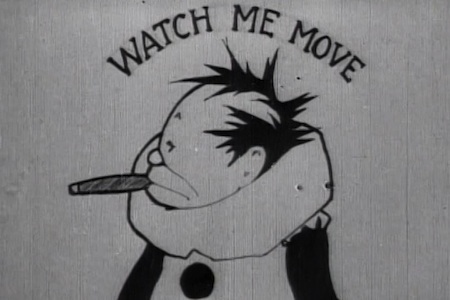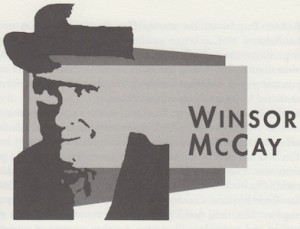Born: September 26, 1867, Spring Lake, MI
Died: July 26, 1934, New York, NY
McCay had no one to consult for guidance in the art of animation.
—Leonard Maltin
The advent of motion pictures offered unique opportunities to Winsor McCay. A product of his traveling sideshows and a legend of the newspaper trade, McCay was better prepared to use the medium of film than any other American artist of the age. He was a conceptual thinker with a rare work ethic, and he was gifted with strong public-speaking skills. He found the wonders of animation a challenging diversion from his daily drawing, and the film industry found itself the perfect pitchman.
The Film 100
1. W.K. Laurie Dickson
2 Edwin S. Porter
3. Charlie Chaplin
4. Mary Pickford
5. Orson Welles
6. Alfred Hitchcock
7. Walt Disney
8. D.W. Griffith
9. Will Hays
10 Thomas Edison
11. John Wayne
12. J.R. Bray
13. Billy Bitzer
14. Jesse Lasky
15. George Eastman
16. Sergei Eisenstein
17. André Bazin
18. Irving Thalberg
19. Thomas Ince
20. Marlon Brando
21. Louis B. Mayer
22. Greta Garbo
23. Robert Flaherty
24. Lon Chaney
25. Anita Loos
26. George Méliès
27. Adolph Zukor
28. John Gilbert
29. Max Fleischer
30. John Ford
31. William Fox
32. George Lucas
33. Linwood Gale Dunn
34. Eadweard Muybridge
35. Katharine Hepburn
36. Winsor McCay
37. Stanley Kubrick
38. Buster Keaton
39. James Agee
40. Fritz Lang
41. Marcus Loew
42. Cedric Gibbons
43. James Cagney
44. Ben Hecht
45. Ingmar Bergman
46. Humphrey Bogart
47. Leon Schlesinger
48. Louella Parsons
49. Roger Corman
50. Edith Head
51. Bernard Herrmann
52. Gary Cooper
53. Mike Todd
54. Ernst Lubitsch
55. Sidney Poitier
56. Saul Bass
57. Billy Wilder
58. Bette Davis
59. Erich von Stroheim
60. Max Factor
61. Auguste and Louis Lumière
62. Woody Allen
63. Clark Gable
64. David O. Selznick
65. Gregg Toland
66. Lillian Gish
67. William Cameron Menzies
68. Lucille Ball
69. Samuel Rothafel
70. Akira Kurosawa
71. Marilyn Monroe
72. Vittorio De Sica
73. Natalie Kalmus
74. Gene Siskel and Roger Ebert
75. Willis O’Brien
76. Shirley Temple
77. Yakima Canutt
78. Sam Peckinpah
79. Jackie Coogan
80. Federico Fellini
81. Leni Riefenstahl
82. Steven Spielberg
83. Sam Warner
84. Jean-Luc Godard
85. Robert De Niro
86. Fred Astaire
87. Francis Ford Coppola
88. Ted Turner
89. Clint Eastwood
90. Dalton Trumbo
91. Dennis Hopper
92. Richard Hollingshead
93. Melvin Van Peebles
94. John Chambers
95. Mack Sennett
96. Martin Scorsese
97. Karl Struss
98. Busby Berkeley
99. John Hubley
100. John Cassavetes
Without much training in art, McCay started his career painting circus signs and fantasy posters for theatrical productions. In 1897, his work as an illustration artist for a carnival promoter caught the attention of the Cincinnati Times Star and he was hired to illustrate criminal trials and sporting events, working his way up to better jobs until he became an editorial cartoonist for the New York Evening Telegram in 1903. He first earned fame in 1905 with his meticulously rendered Little Nemo comic strip, a fantastical adventure strip based on the dreams of an imaginative boy.
In 1906, pioneer director Edwin S. Porter was experimenting with trick photography, and he approached McCay with the intention of using another comic strip as the basis for a short film, Dream of a Rarebit Fiend (1906), which attempted to turn a McCay series of wicked, surreal nightmares into entertainment. To promote the strange film, Porter put McCay in front of national audiences. McCay began making occasional public appearances as the film’s presenter in vaudeville houses. He toured the country with several other productions as well, telling anecdotes about his life as a cartoonist while drawing caricatures of audience members. He was a popular performer, and offers continued to pour in from other venues.
During this time he met Stuart Blackton, another animation pioneer, who experimented with stop-motion techniques on a blackboard. Blacton had developed a reputation for himself in film circles as an important innovator, and McCay was inspired by some of their conversations about the possibilities of animation. Combining Blackton’s crude examples with an idea he got from a child’s flip book, McCay produced a Little Nemo short in 1908 from more than four thousand drawings, each of which was shot onto a roll of 35mm negative film, then developed and hand-colored one frame at a time by the patient and meticulous illustrator. Another attempt at animation was McCay’s The Story of a Mosquito (1912), a hand-drawn flea circus he presented with the Little Nemo film to vaudeville audiences.
Audiences were puzzled; they thought McCay’s mesmerizing drawings were tricks put on with wires and mirrors. An amateur magician, McCay often used sleight-of-hand when introducing these films, which left the audiences skeptical that perhaps more than drawing talent was involved in making the characters move. Disappointed by this first attempt and feeling cheated by the reaction, McCay set himself on a mission to demonstrate the power of moving drawings.
He took a brief hiatus from newspaper drawing and immersed himself in a third film. The production of Gertie the Dinosaur, which began in 1909, was a mammoth undertaking of ten thousand drawings, each inked on thin rice paper. Working with an assistant, McCay conceived many primitive devices to keep the illustrations of his brontosaurus in register, using the corner of a shoebox to align the translucent drawings. Every line in the film’s background—mountain, trees, clouds and a nearby lake—was carefully traced onto each slight variation of the dinosaur’s movement. Within two years, McCay was back on stage.
Gertie was a cultural breakthrough; suddenly audiences realized they were not being fooled. Appearing in person, McCay displayed tall stacks of original drawings before making the extinct reptile come to life on a screen behind him. His live performances consisted of a dialogue between the animator and his creation. The audience stared in amazement as they realized no magical wires or mirrors could create a moving dinosaur before their eyes. Although Gertie did not speak, she responded instantly to every one of McCay’s commands. She charmed audiences with a distinctly demure personality. She was comic and coy. She was alive. She was the first true animated cartoon character.
Gertie was originally shown to fellow journalists and cartoonists from the newspaper business at Reisenweber’s restaurant in New York City before McCay was willing to introduce her to audiences. Present among the group that night was Mighty Mouse creator Paul Terry, who would go on to make nearly fourteen hundred cartoon shorts after the inspiration of the film struck him like a bolt. McCay’s success prompted hundreds of other artists to create cartoon characters.
Winsor McCay took the exhibition clip he used in vaudeville houses and combined it with a live-action re-creation of the Reisenweber gathering to open the film. This included a comprehensive explanation of the drawings require to make Gertie move. The country’s finest theaters showed the official filmed version of Gertie the Dinosaur (1914) and other shorts to their uppercrust patrons. Theaters made animated films a staple of their daily bill. McCay’s sales pitch was over, and the fledgling film industry had already opened a new frontier.
McCay’s next attempt, The Sinking of the Lusitania (1918), was further proof of his prodigious talent. This film had even more drawings than Gertie, boasting the first attempt at twenty-five thousand frames, unheard of in animation circles up to that time and for years to come. McCay produced six more films, but he became disenchanted with the quality of other animators’ efforts and felt that the cartoon industry was not following his lead in the spirit of his original desire for an animated art form. McCay dropped his newfound hobby and returned to newspapers exclusively around 1920. His comic strips waned in popularity, and when he died in 1934, his films went into obscurity until other animators came along to take over in his mold. Major steps in character development and technical advances would later spark new interest in cartoons, but Winsor McCay’s first steps remain among the largest in film history.
To read all the republished articles from ‘The Film 100,’ as well as the complete list of 100 most influential people in the history of the movies, go to Reintroducing the Film 100 here on Keyframe.





